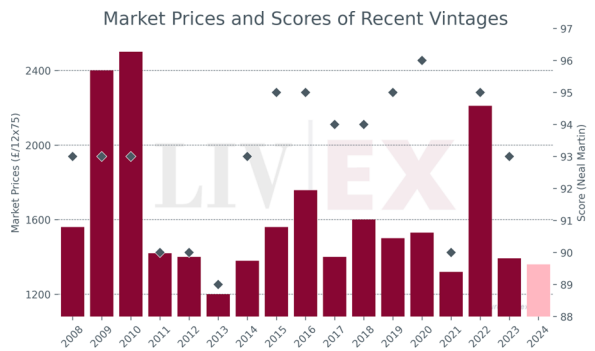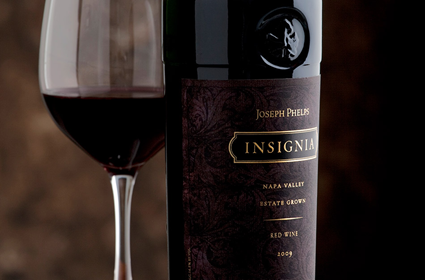
Location: St. Helena, California, United States
Owners: Joseph Phelps family
Founder: Joseph Phelps
First Vintage: 1973
Liv-ex Classification 2019: 2nd tier
2019 Power 100 ranking: 240th
Average annual production: 12,000 to 15,000 cases
Grape varieties: Cabernet Sauvignon, Syrah, Pinot Noir, Chardonnay
Wine style: Bordeaux red blend (Meritage), single varietal
Estate History
In the late 1960’s Mr. Joseph Phelps was running one of the largest construction companies, Hensel Phelps Construction. The company was founded by his father Abe Hensel in 1937 and Joe joined in 1952, moving up to President and General Manager by 1957. One of his construction projects included building the BART (Bay Area Rapid Transit) system in the San Jose/San Francisco area, during which he would frequent Napa Valley.
During his time in the valley he was informed of a few potential winery projects, one of which was to build Souverain Winery (now Rutherford Hill Winery). Following this project, his desire to own a vineyard grew, resulting in the purchase of a 15-acre parcel on the corner of Silverado Trail Road and Zinfandel Lane in 1972. The following year he bought an additional 600+ acres of land, which at the time was unplanted and used for cattle grazing.
Joseph Phelps began by planting Riesling, Guwurztraminer, and Pinot Noir. He soon realized these were not ideal grapes for the region and so switched to the planting of Bordeaux red varieties. The first vintage of Joseph Phelps was in 1973 but was not made on site as the winery was still under construction. Heitz Cellar, just down the road, was used and the fruit was purchased from Stanton Vineyard in Yountville. The 1973 Cabernet Sauvignon was their first vintage and has developed since then to become their most produced wine.
Phelps was a bit of a visionary and wanted to create a proprietary blend of red wine, branching out from the dominant single vineyard offerings of Napa Valley in the early 1970s. In 1974, he created Insignia, which was the first proprietary Bordeaux style blend to be grown, produced, and bottled in California – a style now known as meritage. The percentage of the blend changes but has remained predominantly Cabernet Sauvignon since 1977.
The 1974 blend was 94% Cabernet Sauvignon and 6% Merlot from 100% grower fruit in Stags Leap and Oakville.
The 2017 blend is 94% Cabernet Sauvignon, 4% Malbec and 2% Cabernet Franc from estate-grown Napa Valley vineyards: 46% Las Rocas Vineyard (Stags Leap District), 22% Barboza Vineyard (Stags Leap District), 13% Suscol Vineyard (South Napa), 10% Yountville Vineyard (Oak Knoll District) and 9% Home Ranch Vineyard (St. Helena).
Expanding the brand
In the 1990’s Joseph Phelps started looking into the Burgundian varieties of Chardonnay and Pinot Noir. Needing a cooler region, he swapped valleys and planted 100 acres along the Sonoma coast, where a production facility was built by the Hensel Phelps Construction company. They now produce their Freestone Label there.
Joseph Phelps also produces a ready-to-drink Cabernet Sauvignon in the £25-£35 price bracket, under a sub-brand called Innisfree.
Having been at the helm of the winery for over 30 years, Joe Phelps stepped down as Chairman in 2005 but stayed involved in a role he referred to as “Chief Observer”. In 2015, aged 87, Joseph Phelps died. His son Bill now runs the winery.
The winery’s most recent development was in 2019 when Joseph Phelps joined La Place with the 2016 vintage of Insignia and Cabernet Sauvignon. Opus One, Verite and Inglenook had earlier taken the same route, choosing to use Bordeaux’s marketplace to distribute (at least a portion) of their wines.
USA market performance
The USA has taken a record share of trade value this year, up from 2.3% in 2019 to 6.8% in 2020. Year-to-date USA unique wines traded are more than double that of 2019. Napa is by far the dominant region, but along with the broader market, the market for US wines has been diversifying. Napa market share has fallen from 87.4% in 2019 to 79.6% year-to-date.
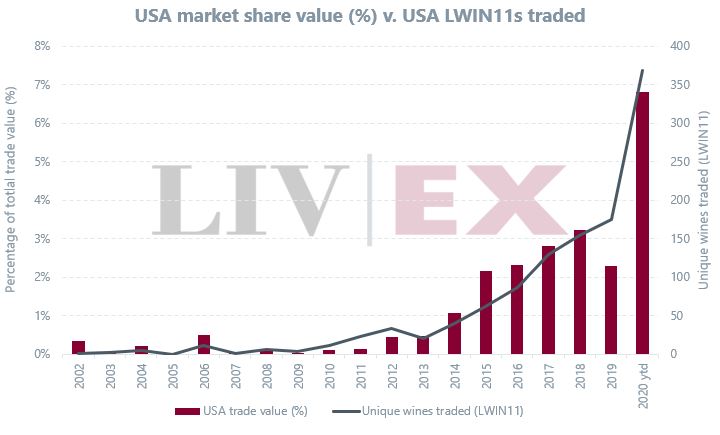
Still, Joseph Phelps is relatively new to the scene. It did not see secondary market trade until 2007, when two cases of the 98-point (RP) Insignia 1995 changed hands. The brand’s market share has since ramped up and year-to-date trade value is at its highest ever, up 3% over 2019. The 2014 vintage has been the most active, with 2016 and 2015 following in close tow. Beyond their flagship wine, the Cabernet Sauvignon has seen action, with the 2015 vintage being the most in demand.
The newest offering of Insignia, the 2017, was released this fall. Joseph Phelps’ winemaker, Ashley Hepsworth, said this would be the rarest offering of Insignia in 20 years. Lisa Perrotti-Brown MW awarded the wine (93-95)+ points, calling it “very promising” and revealing that only 7,500 cases were made – approximately half of normal production.
The performance of the region can be measured by the California 50 index, which does not include Joseph Phelps, but includes many neighbouring wineries. The index is down over the short term: -1.9% year-to-date and -6.4% over two years. However, when seen over three years, the index is up 9.7% and over five years, 81.9%.
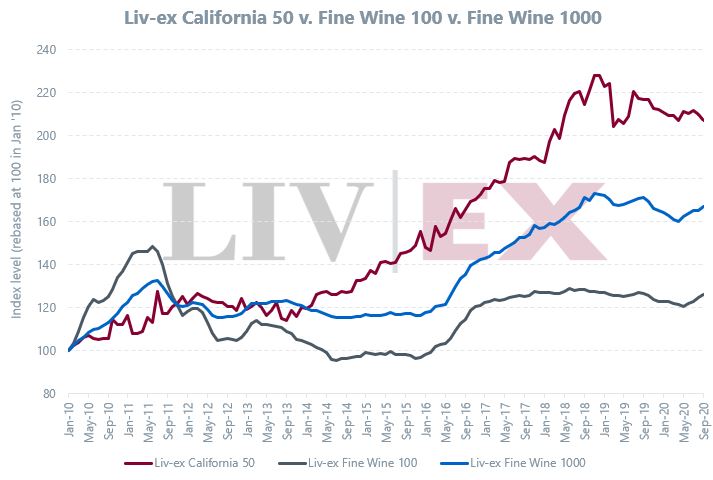
When it comes to demand for Californian wines, bids seem to follow a curious seasonality. In the past five years, around September and October, bids for the region reached annual highs as the newest offerings were released to the market – Joseph Phelps, Opus One, Verite, Inglenook.
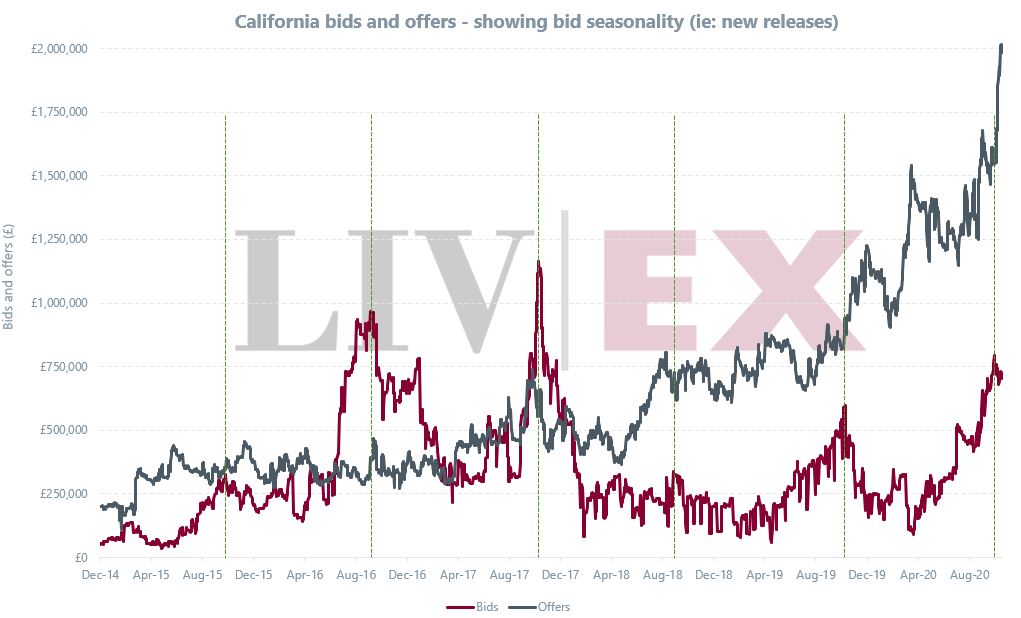
The final chart compares the Market Price of the last twelve vintages of Joseph Phelps Insignia versus their latest Wine Advocate scores. Four vintages of Joseph Phelps have received a perfect 100 from the Wine Advocate – the 1991, 1997, 2002, and the 2007 (seen in the bar chart below). They all trade at a significant premium, nearly double the average case price. One wonders whether the highly rated recent releases (2013-2016) might not deserve a premium of their own?
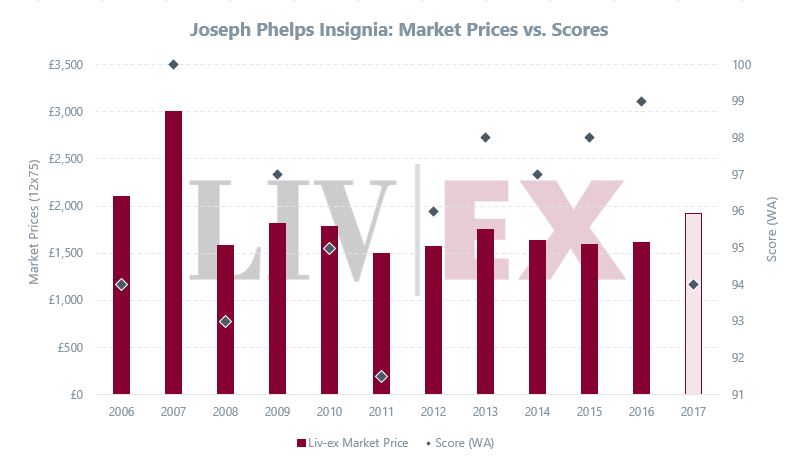
Robert Mondavi, founder of Robert Mondavi Winery, said it the best: “At that time we were purists, we were making Cabernet, Pinot Noir. He [Joe] came up in 1974 with his Insignia… what we called Meritage; he was the forerunner of that. He was the forerunner of coming in with Syrah, the real Syrah, from the Rhone. And people realized that here’s someone who has a vision; he helped stimulate us to go in the same direction.”



